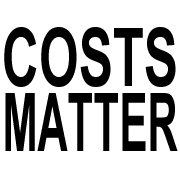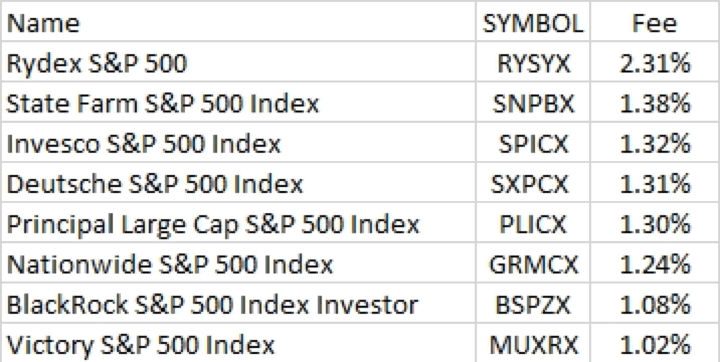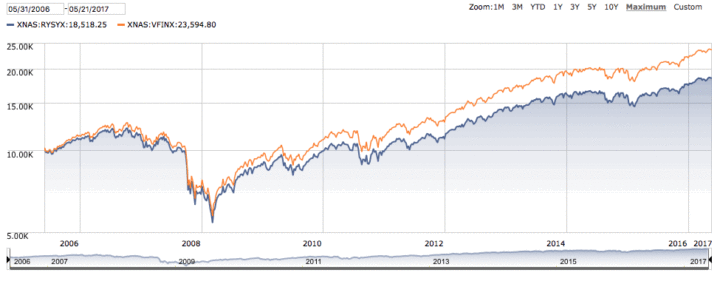
Here’s another reminder that in the world of investing, having low costs is more important than owning “passive” index funds. Why? The simplest argument is that index funds can have high expense ratios.
Anyone can open an account at Vanguard, Schwab, Fidelity, or TD Ameritrade and purchase an S&P 500 index fund with expenses of about 0.05% a year. That works out to $50 a year on a $100,000 balance.
Meanwhile, the following companies have the most expensive S&P 500 index funds on the market. These happily charge you $1,000 to $2,300 a year on a $100,000 balance while investing in the same companies in the same amounts. Credit to Meb Faber for compiling this list.

These could be considered the worst mutual funds out there. Why? If you buy an actively-managed stock-picker fund, at least you have the possibility of outperformance (for a little while at least). You bet on red in roulette even though there is zero and double-zero. With an expensive index fund, you have zero upside. You can’t win. You didn’t even bet on double-zero. Instead, you essentially lit 1% of your money on fire.
Let’s look at the real-world performance of Rydex S&P 500 Fund (RYSYX) and the Vanguard 500 Index Fund (VFINX). Here’s a Morningstar chart showing the relative performance of the Rydex S&P 500 Fund (RYSYX) and the Vanguard 500 Index Fund (VFINX) from the inception of the Rydex fund in mid-2006. This is a “Growth of $10,000” chart, and you can see how the gap just keeps widening over time.
Here’s a quick takeaway from this chart:
- Someone who invested $100,000 in the Rydex S&P 500 Fund (RYSYX) from 5/31/06 to 5/21/17 (~11 years ago) would now have $185,183.
- Someone who invested $100,000 in the Vanguard 500 Index Fund (VFINX) from 5/31/06 to 5/21/17 (~11 years ago) would now have $235,948.
- That is a difference of over $50,000 with no luck involved as both are passive funds that that legally promise in their prospectus to track the S&P 500 index.
- Let me repeat: That’s a difference of $50,000 on a $100,000 starting balance over only 11 years! That is real money; actual dollars that someone will not have to spend in retirement. Imagine what that number could grow into over 30 years of saving.
Isn’t that horrible? Now, consider that the reason why someone would buy these funds in the first place was probably due to a human advisor putting their client in such a fund. Therefore, there is the possibility of another layer of advisor fees on top of the fund expense ratios. (Or they could be options in a bad 401(k) plan. It would be really scary if these were the best options on a plan menu.)
I can’t understand how these companies can get away with charging so much for doing so little. According to Morningstar, the State Farm S&P Index fund (SNPBX) currently has $1.4 billion in assets and the Invesco S&P 500 Index fund (SPICX) has $1 billion in assets. Billions of dollars? Why are so many people buying this stuff?!

 The Best Credit Card Bonus Offers – 2025
The Best Credit Card Bonus Offers – 2025 Big List of Free Stocks from Brokerage Apps
Big List of Free Stocks from Brokerage Apps Best Interest Rates on Cash - 2025
Best Interest Rates on Cash - 2025 Free Credit Scores x 3 + Free Credit Monitoring
Free Credit Scores x 3 + Free Credit Monitoring Best No Fee 0% APR Balance Transfer Offers
Best No Fee 0% APR Balance Transfer Offers Little-Known Cellular Data Plans That Can Save Big Money
Little-Known Cellular Data Plans That Can Save Big Money How To Haggle Your Cable or Direct TV Bill
How To Haggle Your Cable or Direct TV Bill Big List of Free Consumer Data Reports (Credit, Rent, Work)
Big List of Free Consumer Data Reports (Credit, Rent, Work)
It’s not surprising to me that a number of these are insurance company marketed funds — State Farm, Principal, and Nationwide. Even when this industry sells what should be a sensible investment product, they price it in such way so as not to be in their customers’ best interest. I would bet that a lot of these funds are also sold in high cost annuities, adding yet another layer of fees (or even annuities placed in IRAs!) I have to admit that insurance is a fascinating industry with a lot of staying power — fighting a very intense rear guard action in the face of technology and innovation that should have displaced the traditional model years ago.
Some investors may be buying those funds merely because they could be the only option in a 401 (k) plan for example. Small company 401 (k) plans usually have terrible fees. A friend of mine worked for a small company, where all funds had high costs.. Of course, if you want to get a match, you have to contribute to the plan and pay those fees.
One thing that puzzles me about some investors is the need for a financial adviser that burdens the participant with a 1% – 2% charge per year. Paying a financial adviser 1% AUM/year to pick VFIAX for you is as bad as buying BSPZX or MUXRX with their 1% annual charge.
This is frustrating news to read! They should charge an expense ratio of 100% – one year and done! Quick and easy.
Reviewing fees on mutual funds is one thing investors often miss. A fund with a lower return may actually be a better investment if the higher returning fund has substantially higher fees. This issue isn’t helped by the fact that it is often difficult to determine what fees you are actually being charged.